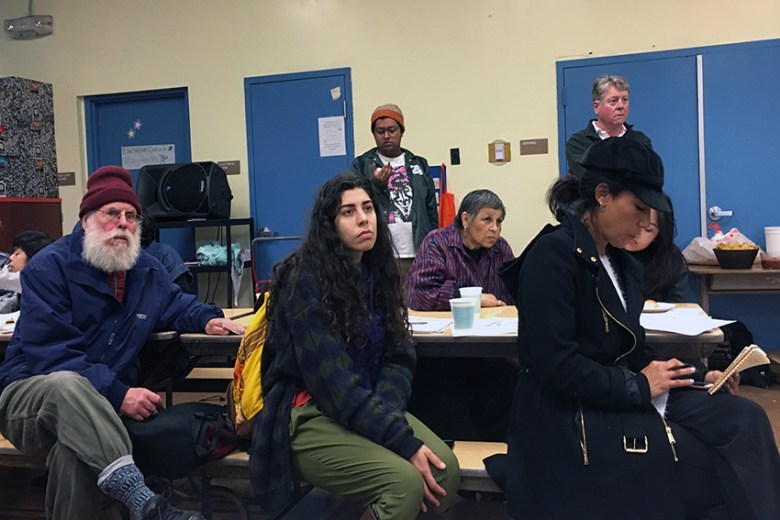A 17-year vision to transform an empty parking lot at 17th and Folsom streets into a recreational park is months away from completion and all that remained to do at Thursday’s final community meeting was to vote on a name.
“The park is almost there,” announced Paulina Araica, the San Francisco Recreation and Parks Department’s project manager, who briefed community members on the park’s proposed features during the meeting held at Marshall Elementary School.
It will open in late May or early June, he said. So on Thursday, the 30 or so residents who attended the meeting got to participate in a vote on one of four names: “Parque Pueblote (Pueblote Park)”, “Semillas Unidas (United Seeds)”, “Parque Corazon Unido (Park Unified Heart)” and “In Chan Kaajal (My Little Town in Mayan)”.
The ballots were collected at the end of the meeting, and the official name is set to be revealed at the park’s grand opening ceremony.
The 32,000 square-foot park will come with features and programming centered around environmental justice and community education. These include a playground and an outdoor fitness area, educational and performance spaces, an interactive water feature and a community garden.
Following construction delays caused by heavy rainfall this winter, the park is now 85 percent complete, according to Araica.

“We wanted to engage folks in community and schools in the area in naming process,” Marilyn Duran, a community organizer with the environment justice group People Organizing to Defend Environmental and Economic Rights (PODER), which is spearheading the community engagement aspect of the park’s construction.
The four options had been pared down from some 20 suggestions gathered in a community outreach campaign led by PODER that involved the creation of a committee of local youth, seniors, parents, business owners and members of the Mission’s Latino and Yucatecan communities.
“Some of the names were pretty weird – ‘Pokemon Go Park ‘was one of the suggestions,” said Duran, drawing laughter from the group. “I don’t think you would have voted for that.”
The pop culture reference did not make the cut.
Some nine community meetings were held with over 100 community members in an effort to coin an official name that would reflect the neighborhood’s cultural and ethnic diversity that included “a big population of Mayan Folks,” said Duran.
“We also talked to middle and high school youth, a lot of [whom] we never think to ask for their opinions,” she said.
Construction for the park broke ground last spring, but the vision for it began over a decade ago when in 2000, a first wave of “gentrification and displacement had really taken a hold of our community,” said Oscar Grande, a community organizer with PODER.
In response, a group of neighborhood residents, leaders and community organizations set out to identify sites that could be transformed into affordable housing, community cultural center and parks, he said.
The need for open space that serves as a communal gathering point, he said, was as prevalent then as it is today. “The Mission District has less than one percent of green, open space in all of the city.”
Planning for the park officially kicked off In 2009 when city partners including Recreation and Parks and the Planning Department became involved. But the project was stalled for a year in 2013 to allow for coordination with proposed sewer improvements that in the end were not implemented.
In 2015, a construction permit was finally granted for the site, said Araica.

But the park is only half of the vision, said Grande. Next door, construction for a 127-unit, 100 percent affordable housing complex is slated to break ground in 2018.
The complex’s residents will have a direct entrance to the park, Araica pointed out in a slideshow that revealed the new park’s design.
The park will initially open from 7 a.m. to 9 p.m. in an effort to discourage “negative use,” but those hours are subject to extension with event permits or per community requests, said Cadi Poile, park section supervisor at Recreation and Parks.
“If there is a community group in the park that is using this space very positively, we can leave it open later than 9 p.m.,” said Poile. “[The limited hours] allow us to guarantee that we have staffing onsite and can make sure that the park is closed, locked and safe.”
Recreation and Parks rangers will patrol the park on rotating shifts, and sensory motion lights will activate it at night.
The park’s operation is “well thought-out,” said Araica, and ideas for its proposed uses and programming were met with a general sense of approval by the meeting’s attendees.
An overview of the park’s seemingly most anticipated feature, the community garden, evoked some questions from the crowd.
One woman expressed concern about its accessibility. “The vegetable beds are not [free] until somebody dies?”
The city currently has a system in place that allows community members who have applied for a plot designated for individual use to exclusively control its growth.
How much of the community garden will be used by community groups or individual community members will be up for discussion with the park’s stakeholders in the coming weeks, said Kimberly Kiefer, Recreation and Park’s director of volunteer programs, who will oversee the community garden.
“Our goal is to frankly do the community garden a little different than we have in other sites of the city,” said Kiefer, adding that she envisions a more “open, accessible, and group gardening” use.


Parque Poder
Poder Parqe!
Should be named after Alex Nieto or Theresa Sparks. Both represented the people and LGTBQ community. They looked different but both had huge hearts and we practically twins in spirit.
How about Bum Acres, Needle Oasis, Bottle Beach?
Tent Turf
And the winner is…. Parky McParkface!